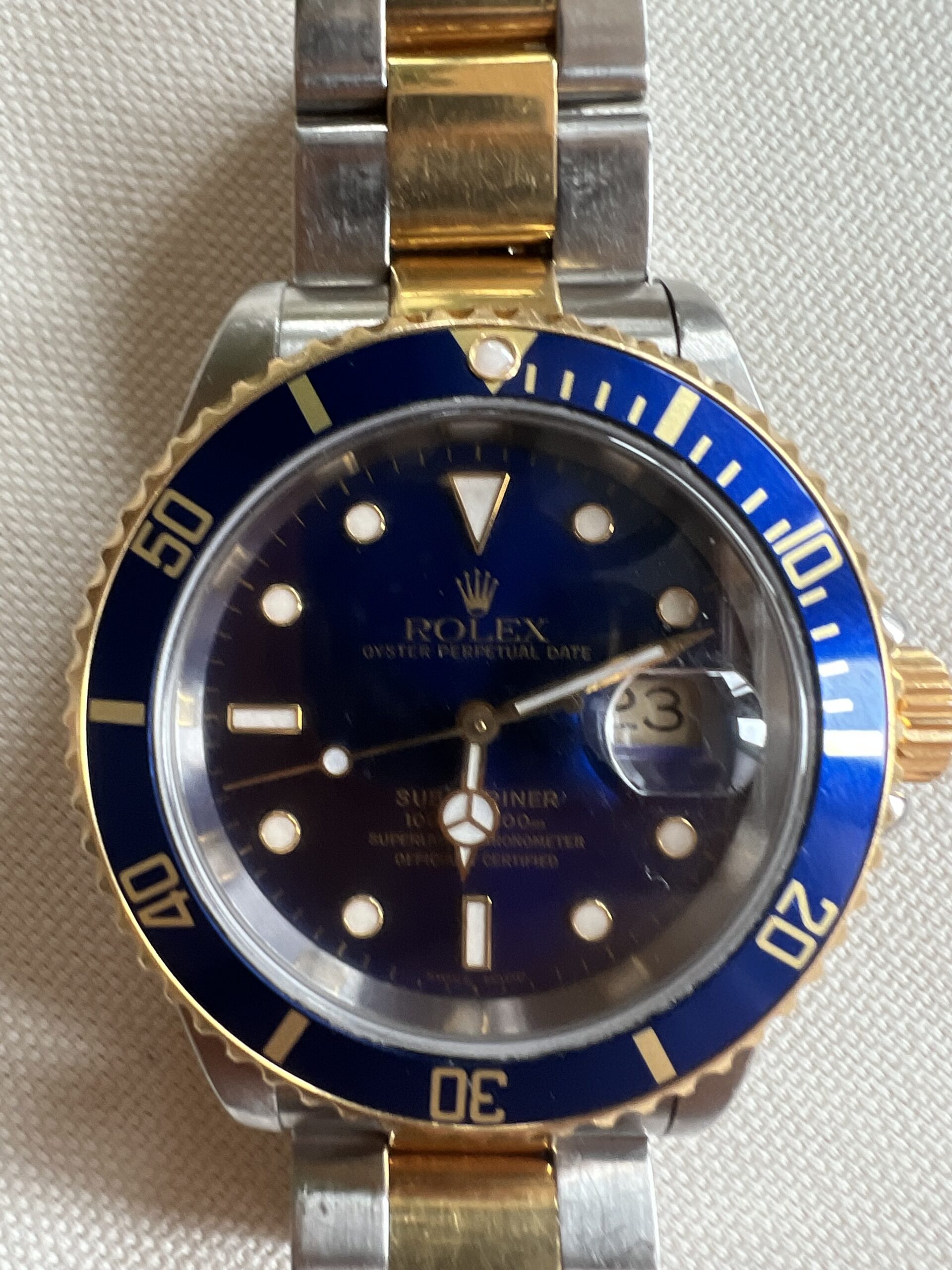Vintage Rolex Submariner Blue Dial 16613 From Circa 2000 2001
The two-tone Rolex Submariner 16613 with blue sunburst dial—often labeled 16613LB for its blue bezel—occupies a sweet spot for collectors and appraisers. Produced from the late 1980s through the 2000s, the reference experienced several quiet evolutions. Examples from circa 2000–2001 often blend classic aesthetics with practical durability, and they sit at a transitional point for luminous materials, bracelets, and case details that matter for authentication and valuation.
Below is a structured, appraisal-focused guide to identifying, evaluating, and valuing a 16613 Blue Dial from around 2000–2001.
What Makes the 16613 Blue From 2000–2001 Special
- Rolesor construction: The 16613 combines stainless steel with 18k yellow gold on the bezel, crown, and bracelet center links. The contrast against the sunburst blue dial creates an iconic late-20th-century Rolex look without veering into dress-watch territory.
- Caliber 3135: A workhorse automatic movement beating at 28,800 vph with quickset date and hacking seconds. Robust, accurate, and highly serviceable, it’s a known quantity for independent watchmakers and brand service centers alike.
- Transitional era details: Around 2000–2001, most 16613 dials read SWISS MADE, indicating Super-LumiNova lume, replacing earlier tritium (SWISS-T<25) and brief SWISS-only (Luminova) dials. This period also saw the wider rollout of solid end links (SEL) bracelets on the two-tone Submariner.
- Wearable vintage: You get the charm of an older aluminum bezel and sunburst dial—with potential for attractive aging—without the fragility concerns associated with much earlier Submariners. Water resistance, if properly serviced, remains strong at 300 m.
Typical serials you’ll encounter for 2000–2001 are P and early K, with serial numbers engraved between the lugs at 6 o’clock. Expect overlap; Rolex used cases out of sequence, so strict year-to-serial charts should be treated as guides, not gospel.
Dimensions to confirm:
- Case diameter: 40 mm
- Lug width: 20 mm
- Thickness: approximately 12.5–13 mm
- Lug-to-lug: approximately 47.5–48 mm
- Bezel: unidirectional, 120-click, anodized aluminum insert
Period-Correct Features to Verify (2000–2001)
For appraisers, matching parts and details to era is central. The following are commonly correct for a 16613 circa 2000–2001:
- Dial text: SWISS MADE at 6 o’clock. Tritium (SWISS-T<25) should be earlier, and SWISS-only tends to cluster just before this period.
- Lume behavior: Super-LumiNova that glows bright green under light exposure, with no patina expected on an unaltered set. A strong long-lasting glow is consistent with Super-LumiNova; tritium would fade quickly after UV activation.
- Case features:
- Drilled lug holes (most examples). Rolex began phasing out lug holes a few years later.
- No rehaut engraving. The inner rehaut with repeating ROLEX text and serial engraving arrived mid-2000s; it should be absent here.
- Crystal: Sapphire with cyclops. The laser-etched coronet (LEC) at 6 o’clock was introduced a bit later (early 2000s rollout), so many 2000–2001 examples will not have it. A service crystal may add the LEC and is not necessarily problematic, but it is not strictly “as-delivered.”
- Bezel insert: Blue aluminum with gilt-tone numerals. Aging to purplish hues is observed and collectible if uniform and attractive. The lume pip should match the dial/hands era.
- Bracelet and clasp:
- Correct period bracelets include non-SEL 93153 (late 1990s) and SEL 93253 (around 2000 onward). For 2000–2001, SEL is common, but transitional crossovers exist.
- Flip-lock Oyster clasp with diver’s extension. Clasp code should align with the production window; treat as a consistency check alongside serial, not definitive proof.
- Some stretch in two-tone bracelets is typical; excessive stretch affects value.
- Crown: Triplock crown (three dots under the coronet).
- Caseback: Smooth exterior, interior with factory markings; no decorative engravings on the outside from the factory. Period examples originally had a green hologram sticker on the back with the reference number—rare to find intact today.
Box and papers for this period should be the perforated/punched-paper warranty certificate, not the later plastic card. Period-correct accoutrements include the green “swimpruf” tag and an anchor fob (300 m), often missing today but additive when present.
Dial, Bezel, and Lume: Nuances That Affect Value
- Sunburst blue vs. flat blue: The hallmark of the 16613LB is its metallic sunburst dial that shifts from royal to electric blue in light. Service dials introduced later sometimes present a flatter, more uniform blue. Original era-correct sunburst dials usually command a premium, especially if free of stains, tool marks at the hands, or blackening around the pinions.
- SWISS MADE legends: For 2000–2001, the expectation is SWISS MADE. If you see SWISS-only on a watch otherwise dating to 2001, ask why. It could be a parts swap or an older case finished later.
- Lume matching: Hands and plots should match in hue and glow. Mismatched tones (e.g., creamy plots with bright-white hands) can indicate partial replacements. Super-LumiNova-era sets are white in daylight; pronounced cream/yellow suggests aging or tritium parts not original to the watch.
- Bezel fade and insert originality: The blue aluminum insert often ages gracefully to violet or denim tones; uniform fade can be desirable. Nicks, dents, or over-polished bezels detract. A service insert is fine but will slightly depress value versus a clean, correct-era original.
- Serti dials: The diamond/sapphire “Serti” dial was an option on the 16613. Value dynamics differ from the standard sunburst blue. If appraising a Serti, confirm originality of the dial/handset pairing and that the dial feet and printing are correct for the reference.
Red flags on the dial include rough or wavy printing, misaligned coronet, incorrect minute-track spacing, and spurious luminant behavior under UV. The 16613 has applied gold surrounds on hour markers; sloppy surrounds or off-center applques should prompt closer inspection.
Case, Bracelet, and Clasp: Wear vs. Alteration
- Overpolishing: Soft, rounded crown guards, thin lugs, or erased bevels indicate heavy refinishing. On a two-tone Submariner, excessive polish can also “wash out” the crisp line where steel meets gold. Sharp, even geometry correlates with higher value.
- Lug holes and end links: A 2000–2001 watch should have drilled lugs. Verify end-link fitment—large gaps or mis-seating may indicate an incorrect bracelet or bent spring bars.
- Bracelet stretch and integrity: Two-tone bracelets naturally stretch with wear. Check for:
- Vertical play between links.
- Thinning or deformation of gold center links.
- Cracking or excessive wear at SEL joints on 93253 bracelets.
- Over-polished gold center links that look “flat” rather than gently rounded.
- Clasp condition: Inspect the flip-lock tension, diver’s extension integrity, and the crispness of hallmark and coronet stamps. A “mushy” flip-lock or deeply over-polished clasp is a value negative.
- Crown and tube: Worn crowns/tubes compromise water resistance and get replaced during service. Replacements are expected over decades; verify they are genuine and correctly specified for Triplock.
Note: Water resistance claims should never be made without pressure testing. For appraisal, assume no water use until a fresh test is documented.
Movement and Service History: Appraiser’s Priorities
The Caliber 3135 in 2000–2001 examples predates the widespread adoption of the Parachrom Bleu hairspring; expect a conventional alloy hairspring with KIF shock protection in this era. Key points:
- Performance benchmarks: Healthy amplitude (e.g., 270–300 degrees dial up, fully wound), stable beat error (ideally ≤0.6 ms), and rate within COSC tolerance. A timegrapher readout substantiates condition in appraisal notes.
- Rotor and reversing wheels: Listen for rotor noise and check for rotor rub inside the caseback—both indicate service needs. Reversing wheels are wear items; sluggish winding points to replacement.
- Date mechanism: Quickset should engage positively with no stutter or lag. Weak action suggests dried lubricants.
- Service documentation: Original Rolex service records materially boost confidence and value. Independent service invoices are also useful, especially if parts replaced are itemized (crystal, crown, hands, insert).
- Parts originality: A period-correct dial and bezel insert typically carry more weight than an original crown or crystal. Service parts are acceptable, but originality premiums are real—note them explicitly.
Service intervals vary by usage; 5–10 years is a practical range. In absence of records, budget for a service in valuation or adjust downward accordingly.
Market Context and Valuation Framework
Values fluctuate with macro demand for pre-ceramic Subs, two-tone fashion cycles, and condition scarcity.
What generally drives value up:
- Unpolished or lightly polished case with strong geometry
- Correct SWISS MADE sunburst dial with original hands that match perfectly
- Attractive, even bezel fade (if present) and clean insert
- SEL 93253 bracelet in tight condition with minimal stretch
- Full “set”: box, punched papers, booklets, tags, anchor, and period accessories
- Documented recent Rolex or reputable independent service
What pulls value down:
- Overpolished case and clasp, severe bracelet stretch
- Mismatched or service dial/hands that don’t align with era
- Incorrect or later bracelet, or non-Rolex parts
- Moisture damage (patina spots, dial bubbling, corrosion)
- Unexplained serial, clasp code, or component inconsistencies
Pricing guidance (cautious, ranges vary by region and timing):
- Head-only, honest wear, service parts present: often mid–four figures to low five figures USD.
- Good example with correct sunburst dial, SEL bracelet, moderate stretch: low-to-mid five figures.
- Excellent example with strong case, tight SEL, full period set, recent service: mid-to-upper five figures.
- Special aesthetics (exceptional violet fade) or unusually complete provenance can push premiums.
For formal appraisals, cite comparable sales within the last 6–12 months, adjust for condition and completeness, and note the presence or absence of service history. Photographically document dial printing, case geometry, bracelet stretch, serial/reference engravings, and movement condition where accessible.
Practical Appraisal Checklist
- Reference and serial
- Reference between lugs reads 16613; serial aligns with P/K period.
- No rehaut engraving; drilled lugs present.
- Dial and hands
- SWISS MADE dial with correct sunburst effect; printing crisp.
- Super-LumiNova behavior consistent; hands match plots in color/glow.
- No moisture spotting, edge lift, or tool scratches around hands.
- Bezel and crystal
- Blue aluminum insert appropriate to era; lume pip intact.
- Insert wear/fade documented; crystal free of chips; LEC absence acceptable for era.
- Case and crown
- Crown guards crisp; chamfers present; minimal overpolish.
- Triplock crown genuine and operating correctly; pressure test if claiming water resistance.
- Bracelet and clasp
- Correct 93153 (late 1990s) or 93253 (SEL) bracelet; fitment tight.
- Stretch measured and photographed; clasp flip-lock tension sound; stamps legible.
- Movement and function
- Timegrapher readings recorded (rate, amplitude, beat error).
- Quickset date positive; rotor free of rub; service needs noted.
- Papers and accessories
- Punched papers for period; tags, booklets, anchor add value.
- Service records copied; parts replaced itemized.
- Red flags check
- Inconsistent dial text or luminous type for year.
- Rehaut engraving present (should not be).
- Non-genuine parts or mismatched bracelet components.
FAQ
Q: Is a 2000–2001 16613 supposed to have the laser-etched coronet in the crystal? A: Not necessarily. Many in this window left the factory without the LEC. If present, it may indicate a later service crystal, which is acceptable but not strictly “as-delivered.”
Q: Should my 2000–2001 blue dial show patina? A: Super-LumiNova dials/hands from this era generally remain white. Patina is more associated with tritium. The blue aluminum bezel can fade attractively; even, natural fade can add value.
Q: Which bracelet is correct for this period? A: You’ll commonly see the SEL 93253 by 2000–2001, though late 93153 examples exist in transitional overlap. Ensure fitment is correct and the clasp code aligns broadly with the era.
Q: How much does polishing hurt value? A: Light, skillful refinishing is acceptable. Heavy overpolish that rounds crown guards, thins lugs, or smears bevels materially reduces desirability and value.
Q: Are service parts a deal-breaker? A: No. Service crystals, crowns, and even inserts are normal over decades. Value is highest with era-correct dial/hands and a clean, original sunburst blue dial. Document any service components in the appraisal.
With careful verification of these period features and a disciplined approach to condition and originality, a 2000–2001 Rolex Submariner 16613 Blue presents a compelling case for collectors and a satisfying, evidence-driven appraisal for professionals.




